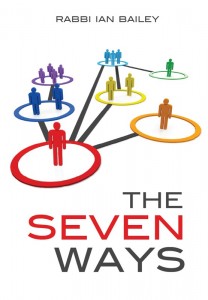Seven Ways Practical Applications II: When You’re the Armchair Coach
PDF Practical Applications IIJimmy, Sam, and Peter have been best friends for years. Having grown up in the same large, bustling metropolitan city, they went to the same kindergarten, the same elementary and middle schools, and the same high school. They took the same classes, including electives, and the same extracurricular activities.
A problem came when they had to do their mid-year capstone project. In order to increase participation from the seniors, who suffered from senioritis and major apathy after their college applications were submitted, the principal had instituted that each student is required to complete a special project which includes key components from the student’s past studies. The trio met in the school library in order to decide on a project.
“We love sports, let’s do sports,” said Jimmy. “Nah, it’s a Jewish school,” countered Sam, “Shall we forsake our heritage?” Peter piped up, “I bet we could get away with doing some of that art stuff we did during that elective we took, remember that?” “Nah,” Jimmy retorted, “I stink at arts n’ crafts—I’m not doing a whole project out of it.” “Sports it is…”
The three young men sat down with their notebooks and pencils and began to research various sports teams. They soon realized that they had a major problem. “Hey, we can’t just write about, like, Jordan and the Chicago Bulls or Miami Dolphins or whatever,” Peter said. “It’s has to be, like, constructive.” “You mean like about exercise and nutrition or something?” Jimmy said. Forget that.” “I told you we should have done something Jewish!” Sam brought up, yet again.
They decided to do what many students at their school had done over the years: “Let’s ask Coach Dan.”
Coach Dan was a wise PE teacher and sports coach. Though he claimed that he never studied Talmud or academic literature, he always had an analytical air about him; he gave sound advice and knew what books the kids would be interested in reading. Students would tell their parents to be more like Coach Dan. “I know Coach Dan,” one parent remarked, “and he not half as educated or smart as me and my husband!” “Stop it, mom, he’s soooooooo smart—really you should speak with him.”
their parents to be more like Coach Dan. “I know Coach Dan,” one parent remarked, “and he not half as educated or smart as me and my husband!” “Stop it, mom, he’s soooooooo smart—really you should speak with him.”
Rumors circulated that the coach sat in a large library at home, smoking a pipe in a suede jacket with tweed elbow patches, studying famous basketball playbooks of Red Auerbach and Phil Jackson.
That afternoon, the three young men filed into Coach Dan office. The coach sat up with start. “What can I do for you young men?” “Hey coach, we got a problem,” said Jimmy. “We’re not sure what to do with this capstone project. We think it’s a whole bunch of baloney.”
“Well, let’s not label and condemn it…but, more importantly, what’s the issue.”
“Well,” Peter answered, “It’s supposed to, like, be constructive and not just about the Bulls or Dolphins.” “Excuse me?” “We’re supposed to do a project and we were trying to figure out what sort of constructive topics we learned about that we could put in.” “And maybe Jewish stuff, too,” Sam included. “I don’t see what’s so wrong with sports,” Jimmy interjected.
Coach Dan did not generally tell youths what to do; he tried to ask them questions socratically in order to get them to think of answers on their own and make decisions from their own choosing.
“Why do you all have to do the same thing? Especially if you each want to do different things?”
“Woaaaaaaaaaaaaah,” Jimmy blurted out, “We should each do different things. I’ll stick with the sports, Sam can review his Jewish studies, and Peter do his art. There are different avenues.” “Sounds good.”
And so it was. Jimmy went for the topic of sports, health and nutrition, and eventually became a trainer for a professional basketball team; Sam wrote about the Jewish studies that he had enjoyed over the years and went on to become an expert in Talmud and Aggadaic literature. Peter’s capstone project was based on the art he had done during an art elective the previous year; he tried to live as an artist but didn’t make enough money so he became an architect during the day to make a living and sold his paintings and sculptures on the side.
Different Personalities
“There are different avenues.”
When someone comes to you for advice, it’s important to coach them with the proper information that relates to their specific personality. When you go to someone for advice, it’s important that you receive advice that fits your unique personality and place in life. People need advice based on their personality. The Seven Ways (it’s available here, email me for a discount code) elucidates seven different types of thinking. Each one needs very different guidance and advice. Jimmy, Sam, and Peter all benefitted from this type of approach to differences in people.
Sam is what I call a Later Chesed (see cheat sheet), as he felt it important to mention the standard System of his surrounding culture. He could have been a gevurah-type as well, if his statements were slightly stronger and more objective sounding. Peter has a personality  that has the creative-oriented tiferet attribute within, such as tiferet or chesed–tiferet.
that has the creative-oriented tiferet attribute within, such as tiferet or chesed–tiferet.
From this story we do not have enough information to ascertain Jimmy’s personality. Upon further investigation, it was revealed that he mentors younger students and was the unanimous pick for nicest student in this class. Though any of the personalities can do these types of actions, in this case these actions were rooted in his natural sweetness. In addition, Hods are very kinesthetic and many like to feel the physical action of playing sports or the rush of riding in a fast car. Hence Jimmy’s desire to focus on the trill that he feels when he plays sports and his hod-based helping he does with athletes to eat properly and stay healthy.
There are different avenues, different paths; finding the right one will make all the difference.
IB * This entire story, its characters, and interaction have been entirely fabricated by me. Any resemblance to real people or their lives is entirely coincidental.
Well, Dan-ny, it was netzach, he seemed to enjoy studying and giving over wisdom, and people perceived him in that was, as well. Thanks for the question, that was good to add!
IB>